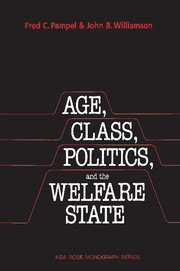Book contents
- Frontmatter
- Contents
- List of tables
- Preface
- 1 The welfare state: some neglected considerations
- 2 Theoretical perspectives on the welfare state
- 3 Social welfare spending in advanced industrial democracies
- 4 Social welfare spending and democratic political context
- 5 Economic growth, social welfare spending, and income inequality
- 6 Infant mortality, equality, and social welfare spending
- 7 Conclusions: The causes and consequences of the welfare state
- References
- Index
- Other books in the series
3 - Social welfare spending in advanced industrial democracies
Published online by Cambridge University Press: 30 April 2010
- Frontmatter
- Contents
- List of tables
- Preface
- 1 The welfare state: some neglected considerations
- 2 Theoretical perspectives on the welfare state
- 3 Social welfare spending in advanced industrial democracies
- 4 Social welfare spending and democratic political context
- 5 Economic growth, social welfare spending, and income inequality
- 6 Infant mortality, equality, and social welfare spending
- 7 Conclusions: The causes and consequences of the welfare state
- References
- Index
- Other books in the series
Summary
Theories of the welfare state discussed in the last chapter make different predictions concerning the influence on welfare spending of class-based political parties and democratic political participation relative to economic and productive structures. They also make different predictions concerning the importance of class cleavages and power relative to economic and demographic groups such as the aged. State-based theories add the organization and power of the state as explanatory factors in the growth of welfare spending. We begin testing these theories and the predictions they make by examining the determinants of social welfare spending in advanced industrial democracies. In so doing, we help to identify the major structural forces that drive social welfare spending and the nature of the welfare state. To what extent is it a response to economic needs of the population, an object of class struggle, or independently shaped by democratic politics, partisan parties, and state structures? Each theory provides a different set of answers to these questions, and evaluation of the theories offers a way to make sense of the complex processes and structures that make up the welfare state.
In this effort, we focus on high-income democracies to the exclusion of low, middle-income, and nondemocratic nations. The causal processes in nations where surplus income is high enough to support extensive transfer payments and democratic procedures allow the nonelite to organize politically no doubt differ from those in nations where income is low and democratic freedoms are few.
- Type
- Chapter
- Information
- Age, Class, Politics, and the Welfare State , pp. 50 - 79Publisher: Cambridge University PressPrint publication year: 1989

